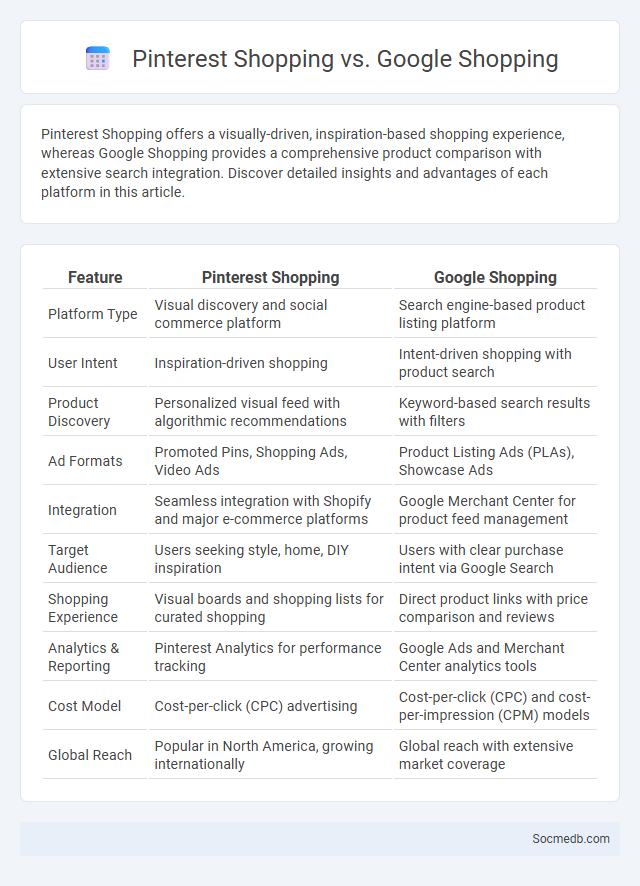
Photo illustration: Pinterest Shopping vs Google Shopping
Pinterest Shopping offers a visually-driven, inspiration-based shopping experience, whereas Google Shopping provides a comprehensive product comparison with extensive search integration. Discover detailed insights and advantages of each platform in this article.
Table of Comparison
| Feature | Pinterest Shopping | Google Shopping |
|---|---|---|
| Platform Type | Visual discovery and social commerce platform | Search engine-based product listing platform |
| User Intent | Inspiration-driven shopping | Intent-driven shopping with product search |
| Product Discovery | Personalized visual feed with algorithmic recommendations | Keyword-based search results with filters |
| Ad Formats | Promoted Pins, Shopping Ads, Video Ads | Product Listing Ads (PLAs), Showcase Ads |
| Integration | Seamless integration with Shopify and major e-commerce platforms | Google Merchant Center for product feed management |
| Target Audience | Users seeking style, home, DIY inspiration | Users with clear purchase intent via Google Search |
| Shopping Experience | Visual boards and shopping lists for curated shopping | Direct product links with price comparison and reviews |
| Analytics & Reporting | Pinterest Analytics for performance tracking | Google Ads and Merchant Center analytics tools |
| Cost Model | Cost-per-click (CPC) advertising | Cost-per-click (CPC) and cost-per-impression (CPM) models |
| Global Reach | Popular in North America, growing internationally | Global reach with extensive market coverage |
Overview of Pinterest Shopping, Google Shopping, and Shopping Integration
Pinterest Shopping enhances user experience by allowing seamless product discovery through visual search and personalized recommendations, driving direct purchases via integrated shopping tools. Google Shopping aggregates product listings from various retailers, using advanced algorithms to optimize search relevance and facilitate price comparisons within the search engine ecosystem. Shopping integration across platforms combines social media engagement with e-commerce, enabling brands to create unified shopping experiences that increase conversion rates and streamline the customer journey.
Platform Audiences and User Demographics
Social media platforms exhibit distinct audience demographics that influence content engagement and advertising strategies. For instance, Instagram primarily attracts users aged 18-34, favoring visual and lifestyle content, while LinkedIn caters to professionals aged 25-49, emphasizing B2B networking and career development. Understanding these platform-specific user demographics enables marketers to tailor campaigns effectively, maximizing reach and interaction within target segments.
Product Discovery and Search Experience
Social media platforms enhance product discovery by utilizing advanced algorithms that analyze user behavior and preferences to deliver personalized recommendations and targeted advertisements. The search experience is optimized through the integration of natural language processing and visual search technologies, enabling users to find products quickly and accurately. User-generated content, such as reviews and unboxing videos, further enriches the discovery process by providing authentic insights and increasing consumer trust.
Integration with E-commerce Platforms
Seamless integration of social media with e-commerce platforms boosts your online store's visibility and drives sales by enabling direct product tagging and instant purchases within apps like Instagram and Facebook. Leveraging social commerce tools helps enhance customer experience through personalized ads, real-time analytics, and streamlined checkout processes. This strategic fusion transforms social media channels into powerful sales funnels, maximizing engagement and conversion rates for your business.
Advertising Options and Costs
Social media platforms offer diverse advertising options including sponsored posts, video ads, and story promotions, each designed to target specific audiences with precision. Costs vary based on factors like platform, ad format, audience size, and bidding strategy, with prices ranging from as low as $0.50 to $5 per click or $6.85 per 1,000 impressions. To maximize Your ad budget, selecting the right platform and ad type aligned with Your marketing goals is essential for cost-effective campaign performance.
Visual Merchandising and Content Formats
Effective visual merchandising on social media enhances brand identity through strategically designed content formats like carousels, reels, and stories that capture audience attention. You can elevate product visibility by leveraging high-quality images, cohesive color schemes, and interactive elements that drive engagement and conversions. Optimizing content for each platform's unique requirements ensures maximum reach and impact in your social media campaigns.
Targeting and Personalization Capabilities
Social media platforms leverage advanced targeting and personalization capabilities by utilizing vast amounts of user data, including demographics, behavior, interests, and location. These capabilities enable advertisers to create highly specific audience segments, increasing the effectiveness of campaigns and driving higher engagement rates. Machine learning algorithms continuously refine ad delivery by predicting user preferences and interactions, ensuring relevant content reaches the right individuals.
Analytics and Performance Tracking
Social media analytics utilize data metrics such as engagement rates, click-through rates, and audience demographics to measure content effectiveness and optimize marketing strategies. Performance tracking tools provide real-time insights into campaign reach, conversion rates, and user behavior across platforms like Facebook, Instagram, and Twitter. Leveraging advanced algorithms and AI-powered dashboards enhances the ability to identify trends, adjust targeting, and maximize ROI for social media campaigns.
Mobile Shopping Experience
Mobile shopping experience on social media platforms is revolutionizing e-commerce by enabling seamless, in-app purchases that combine personalized content with intuitive navigation. Optimized product pages, fast loading times, and integrated payment solutions enhance your convenience and satisfaction while browsing on your smartphone. Leveraging social media's visual storytelling and user-generated reviews, brands can directly influence purchasing decisions through engaging, interactive mobile interfaces.
Choosing the Right Platform for Your E-commerce Strategy
Selecting the ideal social media platform for your e-commerce strategy depends on audience demographics, product type, and engagement goals. Platforms like Instagram and Pinterest excel in visual product showcasing, while Facebook offers robust advertising tools for targeted campaigns. Analyzing user behavior and platform analytics ensures effective customer reach and maximized conversion rates.
 socmedb.com
socmedb.com